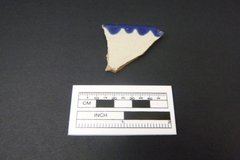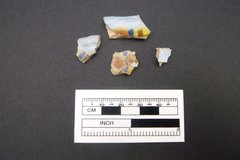Happy Holidays from the Alamo Archaeology Team!
Long Barrack Archaeology Update - December 22
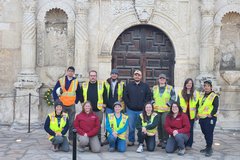
Excavations continued in EUs 2 and 5 this week.
In EU-2, archaeologists excavated to an approximate depth of 30 centimeters below surface. Artifacts include ceramics, two complete glass bottles, and metal fragments. The top surface of the builder’s trench that was in EUs 1 and 3 has appeared in EU-2.
Excavations in EU-5 were completed by archaeologists this week. As in the previous excavation units, the terminal depth was 150 cm below surface. The soils at the base of the unit are clay rich with a lower count of artifacts. The natural hardpan has been exposed in the northern and eastern areas of the unit. Archeologists have started mapping unit floor and unit walls before closed.
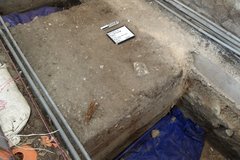
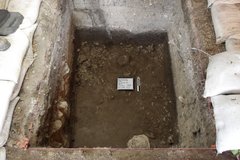
This week we would like to highlight two different ceramic types found during excavations at the Long Barrack. Due to the highly diagnostic attributes of ceramic sherds, this artifact type is critical for archaeologists in creating contextual chronologies. Tin glazed ceramic traditions can be traced back to Europe and were brought to Mexico by the Spanish. The ceramics were eventually brought to the Spanish missions found throughout Texas and the rest of Colonial America. Huejotzingo Wavy Rim Band and Tumacacori Polychrome are Spanish Colonial tin-glazed ceramics, both were recovered from EU-5 at approximately 60 cm below surface.
Huejotzingo Wavy Rim Band is a prevalent ceramic type found within the Alamo site and other San Antonio Missions. This type of ceramic is distinguished from other tin glazes by the prominent wavy band along the rim, with the body of the vessel remaining undecorated. The wavy band can appear green, blue, or yellow, and occasionally one to two decorative bands are present below the rim. Huejotzingo Wavy Rim Band vessels consisted of deep plates and cups. This ceramic type was most likely manufactured in Puebla, Mexico between 1700 and 1800. However, this type did not become prominent in Texas until approximately 1775 to 1825.
Tumacacori Polychrome is frequently recovered from missions and later colonial sites across Texas. Designs on Tumacacori sherds are very distinguishable, consisting of a pale blue glaze and floral motifs along the rim. Vessel forms typically consisted of plates, large platters, bowls, and cups, and were likely produced in Puebla, Mexico. Dates of Tumacacori Polychrome vary, but dates range between 1820 and 1860.
